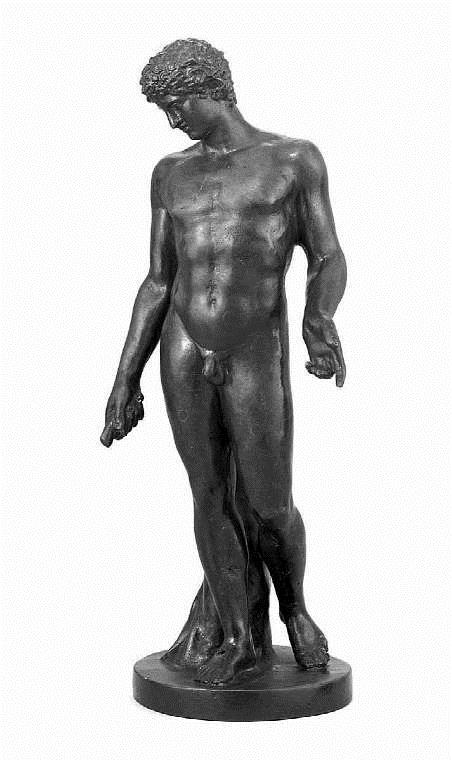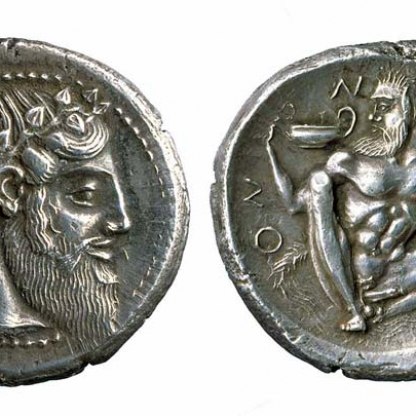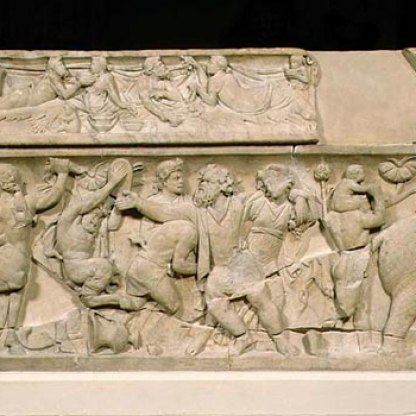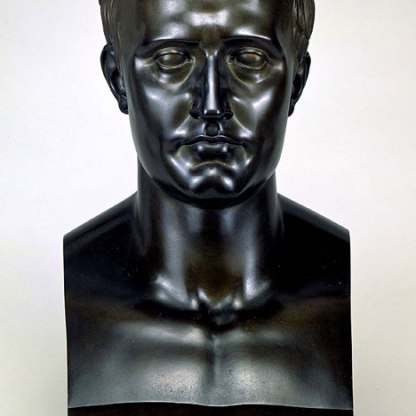Bust of Antinous as Dionysos

Approximately a century after the crucifixion of Christ, another young man of humble, Middle Eastern origin died and was acknowledged as a god.
Antinous, from the province of Bithynia on the Black Sea coast, was the beloved companion of the Roman Emperor Hadrian, and in October 130 CE he drowned in the River Nile. No one quite knows how this came about. It might have been an accident. It might have been an act of self-sacrifice. It might even have been murder. Whatever the cause, Hadrian was grief-stricken and, soon after, he declared that the youth had been reborn as a god. He built a great city, Antinopolis, at the site of the tragedy, and a cult to his dead favourite was established that lasted well into the fourth century CE.
This new god sprang fully armed with an instantly identifiable imagery. In death, as in life, Antinous’ appeal lay in his youth and beauty, and his face became one of the best known in the Roman world. The handsome, sensual features of this statue – with its round face, almond eyes, strong brows, full lips and thick, tousled hair – are found on many other representations from all over Hadrian’s empire. Coins bearing the deified Antinous’ image have been found as far north as Godmanchester in Britain.
Although Roman emperors were customarily deified after their deaths, it was unique for a commoner to be so honoured, and in art Antinous was often assimilated with other, more traditional gods. Sometimes he is represented as Apollo, the eternally young and beautiful Greek deity. At other times he is the messenger god Mercury (Greek Hermes). A number of statues show the deified Antinous in Egyptian costume, and here an association with the Egyptian god Osiris is possible.
The Greek city of Mantineia became a centre for the worship of Antinous. A festival and games were held there in his honour every four years, and in the stadium he was depicted as the wine god Dionysos (Roman Bacchus). It is as this deity, his luxuriant hair bound with ivy tendrils, that he appears in the Fitzwilliam bust. A small first-century BCE bust in the Fitzwilliam, below GR.119.1937, depicts Dionysos in this traditional way.

The identification between Dionysos and Antinous went beyond the visual. Like the Greek wine god, Antinous was believed to have died and been reborn. Members of his cult would re-enact his death and resurrection, and were thus offered hope for their own immortality.
Antinous was also prayed to for more general, earthly acts of benevolence. Inscriptions from the time refer to him as ‘Antinous the Good', and, as a new deity, he was approached to intercede with the older, more established gods. There are records of his appearing and healing the sick in dreams. An unrequited lover in Egypt even invoked Antinous to help him win the object of his affection.
This bust was unearthed in the eighteenth century at the site of Hadrian’s great villa at Tivoli, where it is now becoming clear there was a huge sanctuary, including an area that was possibly dedicated to the worship of Antinous. The Scottish painter, archaeologist and dealer Gavin Hamilton (1723–98) secured it for the Marquess of Shelburne, whose personal collection of antiquities in Lansdowne House, London, it graced until 1930.
More than twenty images of Antinous have been unearthed from Hadrian’s Villa. A cast of one of these – now in the Capitoline Museum in Rome – can be seen in a niche high up in the entrance hall of the Fitzwilliam.
As Christianity gradually took hold in the Europe, the cult of Antinous died out. But the romance of his tale was not forgotten. Below is a late sixteenth-/early seventeenth-century bronze, in the Fitzwilliam M.7-1953, depicting the tragic and beautiful man-god.

Themes and periods
Data from our collections database
Antinous, head of
Legal notes
The Ricketts and Shannon Collection. Bequeathed by Charles Shannon, 1937
Acquisition and important dates
- Method of acquisition: Bequeathed
- Dates: 1937
Dating
Maker(s)
Place(s) associated
- Italy
Materials used in production
Read more about this record3D scan
Accessibility Notice:
The 3D model on this page is hosted on Sketchfab and may not be fully accessible to everyone, including users of assistive technologies. We apologize for any inconvenience.
Audio description
Other highlight objects you might like
Suggested Curating Cambridge products
Sign up to our emails
Be the first to hear about our news, exhibitions, events and more…





